Chris Hardwick's Blog, page 2144
March 9, 2017
All the Easter Eggs in the DEADPOOL 2 Teaser
We all had a great time watching the teaser for Deadpool 2 that was attached to Logan last weekend. While having nothing at all to do with what the hotly anticipated follow-up to Deadpool will actually be—it’s just a teaser after all—it did offer a nice glimpse at Wade Wilson (Ryan Reynolds) trying to do the right thing but utterly failing because of silliness. And while a simple three-and-a-bit minutes on the Fox backlot certainly scratched our Deadpool itch, it also tossed in several Easter eggs that savvy fans have been picking up on…including savvy fans in our editing department!
The above video gives a breakdown of these Easter eggs and what they might in fact mean. Most notably, graffiti written on and around the phone booth and neighboring wall reference characters tied to Deadpool, notably Nathan Summers (a.k.a., Cable, who has yet to be cast) and possibly even Hope Summers, another member of X-Force. Wade also walks by a movie theater showing Logan, a fun meta reference to both the movie this teaser played before, and the fact that Deadpool is obsessed with Hugh Jackman.
Two of my favorites are posters for Firefly being seen over Wade’s shoulder at one point—most likely due to Morena Baccarin appearing both in that series and in Deadpool, but might also hint at Nathan Fillion being cast as someone (we’re hoping)–and the fact that the tiny-font, fast-scrolling text at the end of the teaser is actually the entirety of Ernest Hemingway’s novel, The Old Man and the Sea. That’s pretty weird.
Did you catch any Easter eggs we missed? Are we on or off base with any of our picks? Let us know in the comments below!
Image: Fox
More about Logan from the stars themselves…
RIVERDALE Recap: Chapter Six – In a Lonely Place
There were some big revelations in the seventh episode of Riverdale. This series doesn’t hold back; it is not afraid to answer questions and tie up dangling threads. Sure, Jason Blossom’s still-unsolved murder is a big driving force of the show, but other than that nothing is left unanswered. From Polly’s disappearance to Betty and Jughead’s make out session, it all came into play this week.
Jughead was center stage in “In a Lonely Place”—his troubled home life had led him to a squatter’s life. With the drive-in closed, Jughead had taken refuge in a janitor’s closet at Riverdale High. The episode opened with a dream sequence in which Jughead struggled to fit in with his friends and their families. It was dark and bizarre, especially since everyone was dressed just like their classic comic book counterparts. Twisted and fun, this scene was Riverdale doing what it does best.
Archie immediately found out that Jughead was sleeping at the school—since nothing stays a secret in the town of Riverdale—and tried desperately to get his friend to come stay at his house. Jughead was too proud though, so Archie went with Plan B: get Fred Andrews to hire Jughead’s dad back at the construction company, which would then obviously solve all the Jones’ domestic problems. Fred agreed to give Mr. Jones another chance and, shockingly, this did not solve any of Jughead’s problems.
In fact, you could say things got worse.
Jughead’s dad is a criminal, a drunk, and the leader of a biker gang. Skeet Ulrich owned the screen this week, what with his charm and swagger. His portrayal of Mr. Jones—did we ever get a first name?—is pitch perfect. in fact, one of the episode’s best moments came when Ulrich and Luke Perry’s Fred Andrews took Archie and Jughead to dinner. Perry and Ulrich should have their own show, two grizzled bachelors out in the world, drinking milkshakes and taking names. I’d watch the hell out of that.
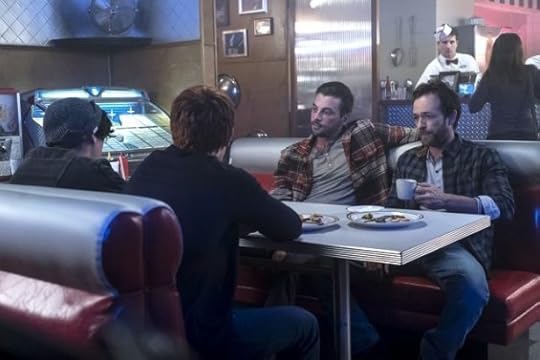
Despite his best effort, Jughead couldn’t keep his dad on the straight and narrow. The cops tried to pin Jason’s murder on Jughead (with no real evidence or reasoning), forcing Fred had to come and get Jughead out of the trouble. Jughead’s dad is nowhere to be found, abandoning his kid yet again. By the end of the episode, Jughead has moved into the Andrews’ house.
Mr. Jones’ downward spiral into alcoholism led to the episode’s biggest reveal: Jason’s letterman jacket hanging in the closest at the Jones’ house. The obvious conclusion is that Jughead’s dad is the one who set Jason’s car on fire at the end of the last episode. But why? Sure, we could assume that he murdered Jason. That would make sense since, as we’ve noted in the past, Skeet Ulrich is literally always the killer. It’s more likely that Mr. Jones was selling Jason the drugs that were stuffed into the trunk of the car and the fire was to cover that up. Or Skeet is the killer because of course he is!
Elsewhere, Veronica addressed the conflict with her mother by using the one weapon all teenagers have in their arsenal: acting out and partying hard. Veronica went clubbing, got drunk, and danced her ass off. Her mom caved—it was school night!—and agreed to negotiate with her daughter. The result was that Mrs. Lodge had to admit to her incarcerated husband that she had forged Veronica’s signature in order to give a construction contract to Fred Andrews.
The other big plotline this episode was Polly Cooper’s disappearance. If you thought her escape from the mental institution last episode was a tease for something further down the road, you were wrong. Instead, this mystery was solved almost instantly when Betty discovered that Polly was just hiding in the Cooper’s attic. Betty managed to keep this secret from her parents, which was a miracle because Betty is a terrible liar.

While trying to figure out how to best help Polly, Betty and Jughead’s relationship is exposed to everyone and—twist!—Archie seemed sorta jealous. You had your chance Archie, don’t be a dick, dude. Betty and Jughead’s thing is sweet and there was some awesome chemistry between the two characters. However, there was something about Betty’s demeanor that would suggest Jughead has some heartbreak headed his way. He just seemed more into her than she was into him, right?
Anyway, with Polly in hiding, the town folk began assuming that she killed Jason. The Blossoms certainly thought so, as they took to the woods with freaking dogs to hunt down Polly. In order to clear their name, Alice Cooper held a press conference and told everyone that Polly was in a mental institution when Jason was murdered, so she couldn’t possibly be the killer. Oh, and they announce that Polly is preggers with Jason’s baby, which freaked out the Blossoms, especially Cheryl.
In the end, Polly eluded her family and the Blossoms by going to stay with Veronica and her mom. So, the Coopers still think Polly is on the run, but homegirl is really just down the road in downtown Riverdale. Nobody escapes this town, guys. Nobody.
What’s your favorite plotline in Riverdale so far? Sound off in the comments below!
Images: The CW
Buster Keaton and Why Silent Comedy Still Matters
We’re fast approaching the 100th anniversary of the heyday of silent cinema. While not everything from that era has stood the test of time–as a matter of fact, only around 20% of films made during the silent era even exist anymore–comedy and horror have had the best go of it. Nevertheless, it seems more and more that the classic silent comedians are becoming qualified as quaint nostalgia, instead of being heralded for the powerhouse of laughs they earn. My very favorite of these old greats is Buster Keaton, who is gearing up for a much-needed rediscovery: Kino Lorber is now releasing brand new 2K transfers of four of Keaton’s films.
Most people agree that the big three names in silent comedy were Charlie Chaplin, Harold Lloyd, and Buster Keaton. While I love all three (read my review of Chaplin’s The Kid and an appreciation of Lloyd‘s work), I think Keaton has earned solid ground as my favorite. He got his start in shorts as a foil to Fatty Arbuckle and would then go on to star in his own (read my review of his Shorts Collection here). Beginning in 1923, he started essentially writing, directing, and starring in his own feature films, mostly free of interference from producer Joseph M. Schenck. These films represent some of the purest expressions of an artist who filled his movies with gag after gag.
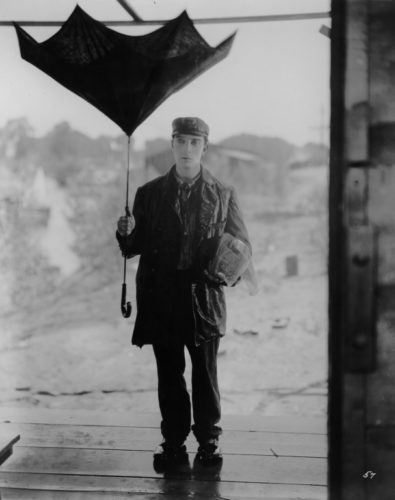
While Chaplin’s movies made the most money per film, and Lloyd made the highest grosses in total, Keaton was a bit more of an acquired taste. They didn’t always make money, and certain critics at the time–namely the trade papers and The New York Times–were not kind at all to his breed of comedy. Still, I think his humor has stood the test of time the best. His stoneface demeanor feels right at home in today’s deadpan comedy space, and his amazing acrobatic stunt work remains incredibly influential, most notably to Jackie Chan.
The films released by Kino in this newest batch, carefully and painstakingly restored by Lobster Films, represent some of Keaton’s best known and most beloved films. Three Ages was Keaton’s first feature as director, and he swung for the fences immediately. A parody of D.W. Griffith’s three-and-a-half-hour 1916 epic Intolerance, Three Ages intercuts three different eras of human history–cavemen times, Ancient Rome, and the roaring ’20s, following the lead character in each (Keaton all three times) as he attempts to find love. Having already directed 20 very successful short films, Keaton’s structure for Three Ages allowed for essentially interwoven shorts, but still with a narrative thrust throughout.

The basic boy attempting to court girl storyline for each of the ages allowed Keaton to explore many different avenues for comedy, employing physical gags and prop humor specific to those different times. Keaton, throughout his career making independent shorts and features, was all about crafting specific bits that showed off his timing, his reactions, and his supreme athleticism. While the shorts retroactively feel like a precursor to Looney Tunes (a basic framework to contain various hilarious set pieces), Keaton made a point to spend time crafting the narrative of his features, making sure they worked both as films and as gag depositories.
While Three Ages showed off Keaton’s potential for scale and scope in his direction, the other three films each showcase a specific aspect of his talent, beginning with his arguable masterpiece: 1927’s The General, a movie that was incredibly ahead of its time in the untapped field of the action comedy. The story of a Civil War nobody who chases down a stolen prize locomotive known as “The General,” who then turns it around and heads back the way he came with enemy soldiers on his trail all the while, gave the film a glorious percussive sense of pace, where Keaton was able to show off his acrobatics as well as his sense of humor.
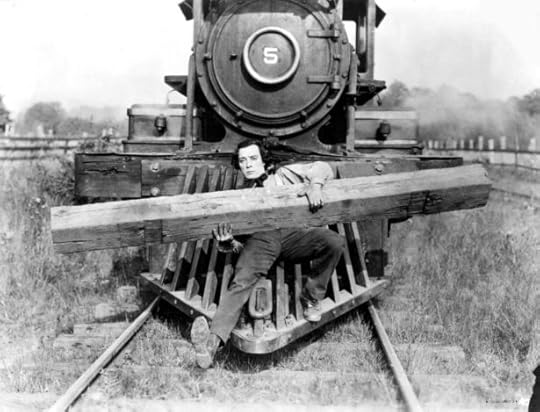
The General is much more of an action movie than a comedy by today’s standards. Watching it again recently, it’s easy to see why someone like Jackie Chan emulated Keaton in terms of how he shows action–in wide shots, in order to show off the physical prowess and “realness” of the stunt in question. Keaton is actually riding on a runaway train engine, and he’s actually risking his life hanging off of it.
It’s also impossible to ignore what is clearly this movie’s influence on George Miller’s Mad Max: Fury Road. The basic structure is identical: People in a vehicle go as far as they can in one direction, being pursued by enemies, there’s a moment to reflect, then they turn right back around and go back where they came, all on that same mode of transport. But, as with Mad Max, The General offers little moments and hiccups and obstacles along the way to build the excitement. It’s a masterwork.
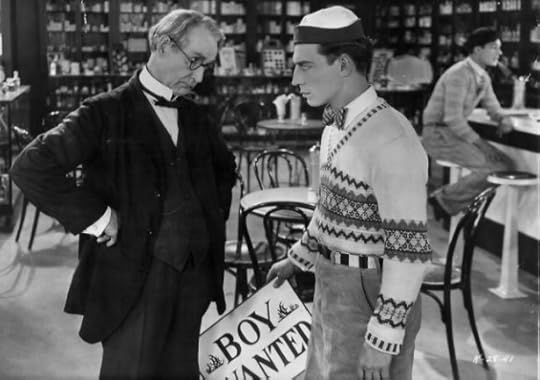
Unfortunately, people didn’t really care for The General at the time, and the picture lost a considerable amount of money for producer Joseph M. Schenck, who told Keaton he’d have to play much more in established, safer genres. The result was College, a movie that feels incredibly similar to Harold Lloyd’s The Freshman, where Keaton plays a new student at an esteemed university. The character is a smart guy but is trying to prove himself as a physical specimen and sportsman. Obviously, Keaton’s character was supposed to be a complete buffoon on the field of play, but this meant the real Keaton–who was incredibly cut, given what a physical comedian he was–had to go over the top with how inept he was, tossing his body around like a rag doll while being crappy at shot put or hammer throw, and overrunning the bases on the baseball field, getting his whole side out.
Keaton’s his final independent feature before going to MGM would be one of his finest: 1928’s Steamboat Bill Jr, showcase for everything Keaton had honed up to that point–enormous set pieces, acrobatic stunts, a boy-meets-girl storyline, and well-crafted, clever slapstick. Keaton often reminds me of a human Looney Tune and Steamboat Bill Jr is like that to a T. Surely you’ve seen the gag where someone is standing in front of a house/building and the whole front of it falls forward, and the man is only not killed because they’re standing directly where the window is? That’s Buster Keaton, and that’s from this movie, which ends with a massive typhoon hitting a town and Buster getting blown away in it.

Keaton’s work may have not been for everybody at the time, but I think he’s aged the best of any of the major silent comedians. Though most of our comedy today is based on improvisational dialogue (which gets old), it’s the tone and delivery–often deadpan, and usually at the expense of a sad sack main character–that strikes so close to Buster. Go discover or rediscover Buster Keaton’s work and see what I mean.
Let me know in the comments below what your favorite silent comedy is and why!
Images: Kino Lorber/Lobster Films
Kyle Anderson is the Associate Editor for Nerdist and a lover of comedy from all ages. You can find his film and TV reviews here. Follow him on Twitter!
Could GAME OF THRONES Change the Game in Season 7?
If you love watching ice melt, then HBO had a treat for you this morning! For over an hour on Facebook Live, Game of Thrones fans around the world gathered online to witness flames slowly (and we mean s-l-o-w-l-y!) burn away the ice to reveal the seventh season will drop on Sunday, July 16th. But that isn’t the biggest news shaking the realms of gods and men: A new character is coming to Game of Thrones, and today’s Nerdist News is all about how his presence on the show could confirm a long-standing theory!
Before we go any further, there are potentially major spoilers ahead for GoT season 7 ahead! It’s all rumor and speculation until it turns out to be true, though. Either way, you’ve been warned!
Join host and last of the First Men, Amy Vorpahl, as she explains how Jim Broadbent’s new character may shake up the show. Broadbent has confirmed that he will be in at least five episodes out of the shortened seven episode season. He’s also said that his character will primarily play off of Samwell Tarly, and that he will have a major scene in each of his episodes. Naturally, this seems to support the theory that he’s Maester Walgrave or Marwyn the Mage or some amalgamation character that combines aspects of both men. However, that’s not the exciting part.
Our Managing Editor, and cousin of dragons, Alicia Lutes, has stepped up with a major theory of her own that may blow the show wide open. It’s long been speculated that the Maesters actively suppressed knowledge about magic in Westeros as a way to consolidate their power. They also had a part in allowing Robert’s Rebellion to bring down the Mad King. Surely the Maesters would be less than pleased to see Daenerys Targaryen ride back into power alongside her dragons. The Maesters may even turn out to be Daenerys’ secret enemy that no one even saw coming; which should make things awkward for Sam if he has to choose between joining the Maesters or standing alongside Jon Snow and Daenerys in the fight to save the realm.
What do you think about the newest GoT theory? Melt some ice in the comment section below!
Ryan Reynolds Announces Domino Casting for DEADPOOL 2
This has been a big week for announcements from major franchises being made by making people try to see words through obstructions (I’m looking at you, Game of Thrones premiere announcement). Luckily for fans of Deadpool, we didn’t have to wait an hour for a live stream of frigging ice melting to reveal the name of the actress cast as Domino in the hotly anticipated X-franchise sequel, we just had to figure out what the hell this thing said:
Domino Effect. pic.twitter.com/ILEnTcW7fY
— Ryan Reynolds (@VancityReynolds) March 9, 2017
From actor Ryan Reynolds‘ own Twitter account, we have a picture of weird pizza-looking dominoes, in which is written a name, and that name is Zazie Beetz, the actress who is best known for playing Vanessa in FX’s awesome Atlanta. A relative newcomer to acting, Beetz has very clearly made a splash to the Fox casting execs during her six episode run on the studio’s premier cable channel.
Just to hammer the point, Reynolds later tweeted this:
Zazie Beetz Effect. pic.twitter.com/Kvtyk1aI7O
— Ryan Reynolds (@VancityReynolds) March 9, 2017
Earlier this week, speculation stemming from a little-seen YouTube show claimed that recording artist and actress Janelle Monae was cast as Domino, but Deadpool co-writer Rhett Reese shut that talk down very quickly in tweets that have since been removed (damn). That was only a couple of days ago, so it seems likely the producers wanted to nip that particular out of control rumor in the bud.
For those who don’t know, Domino is a former mercenary turned member of the X-Men, who has the innate mutant ability to manipulate probability in her favor, making her exceedingly lucky in addition to being a world class marksperson and hand-to-hand combatant. She has been most often paired with Deadpool and Cable, both of which will be featured in Deadpool 2 and the upcoming X-Force movie.
What do you think about Zazie Beetz being cast as Domino? How long did it take you to read the name in those damn dominoes? Let us know in the comments below!
Images: Activision/Marvel / FX Networks
Kyle Anderson is the Associate Editor for Nerdist. You can find his film and TV reviews here. Follow him on Twitter!
Just how strong is X-23?
Perspective-Warping ‘Flatland II’ Photos are Disorienting and Beautiful
Just over a year ago, we told you about Turkish artist Aydın Büyüktaş and his amazing images that force us to consider landscapes from a new perspective. Inspired by Edwin Abbott’s book Flatland: A Romance of Many Dimensions, he combined 3D modeling and photography to create images that appear to have been adapted from two dimensions. As we previously explained, it’s something like this: imagine existing on a flat piece of paper, a two-dimensional world. The dimensions you know are length and width. If somebody lifted one end of that piece of paper, they would see it as being curved, but to the two-dimensional being, they wouldn’t notice the change. They have no concept of a third dimension, depth. If that’s not doing it for you, think about a Möbius strip and perhaps that’ll add perspective.
We bring this up because Büyüktaş is back at it again, with a series he’s calling “Flatlands II.” Last time, he applied his bizarre photo effects to Istanbul, but this time, he’s broadened his settings. For this series, he searched for areas and planned for two months. Shooting took a month (and 10,000 miles of travel). From there, the collages, which consist of 18 to 20 photos, were compiled over the course of a couple months. That effort has yielded perspective-warping takes on an abandoned greenhouse, a football field, a plant nursery, a parking lot, a junkyard, and others. The bridge is especially alarming, since it makes you feel like you’re about to drop onto an extremely steep road, which feels pretty much like a paved cliff face.
If you’re still struggling with all that dimensional talk we got into earlier, this video that imagines what a tenth dimension would be like should be helpful (and also speaks more about the original Flatland book). If you just want to see more mind-bending images by Büyüktaş, check out our gallery below.
Images: Aydın Büyüktaş
Comic Book Club: Brian Wood and Kevin Maher
Brian Wood (“Brigg’s Land,” “Rebels”) and Kevin Maher (Kevin Geeks Out) join the show to discuss their favorite gorillas (and other things). Plus reviews of America #1, The Walking Dead #165 and Superman #18.
Check out the website at comicbookclublive.com to find out how to watch the show live! And follow the show on Twitter: @comicbooklive, @azalben, @jtsizzle, and @realpetelepage
Take a Peek Inside GUARDIANS OF THE GALAXY: CREATING MARVEL’S SPACEFARING SUPER HEROES (Exclusive)
It’s poised to be a big year for Marvel Comics’ cosmic super team the Guardians of the Galaxy, with a sequel to their 2014 blockbuster hitting theaters in May. But it wasn’t that long ago that Guardians of the Galaxy was just a comic book with a small and loyal cult following, known only to hardcore fans. Originally created back in 1969, the first iteration of the Guardians was set in the 30th century, a kind of answer from Marvel to DC Comics‘ own future team, the Legion of Super-Heroes.
This version of the team made sporadic appearances in the ’70s and ’80s, and finally they received their own ongoing series in the ’90s for five years. In 2008, Marvel decided to revive the name Guardians of the Galaxy as a modern day spacefaring team of misfits, made up of an oddball assortment of their various cosmic characters, many of whom hadn’t had a high profile in decades. This was the version of the team that became a hit — and ultimately spawned the movie version that made Star-Lord, Groot, Rocket, Drax, and Gamora household names.
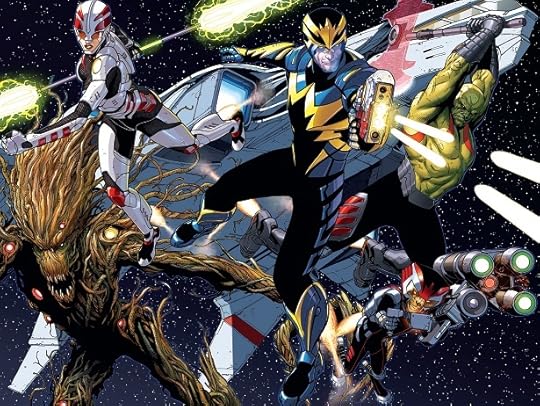
Just in time to celebrate the release of the Guardians of the Galaxy: Volume 2, publisher Insight Editions is releasing Guardians of the Galaxy: Creating Marvel’s Spacefaring Super Heroes -The Complete Comics History, from Eisner-award winning writer Marc Sumerak. The new deluxe hardover book delves into the creation and evolution of the Guardians through exclusive interviews with the writers and artists who have brought them to life over the years.
Filled with incredible art from nearly fifty years of comics, this deluxe art book reveals the secrets behind the genesis of fan-favorite characters like Star-Lord, Drax the Destroyer, Gamora, Rocket Raccoon, and Groot. The book comes complete with a specially commissioned cover illustration by artist Dale Keown, and this comprehensive collection takes fans on a dynamic journey into the creation of the greatest art from five decades of Guardians of the Galaxy comics.
Guardians of the Galaxy: Creating Marvel’s Spacefaring Super Heroes – The Complete Comics History hit stores on April 4, and you can pre-order your copy on Amazon now. To seen an exclusive preview of several pages from the book, be sure to take a peek at our gallery below.
Are you a big Guardians of the Galaxy fan? Let us know your thought’s on Marvel’s #1 cosmic team in the comments below.
Images: Insight Editions / Marvel Comics
Here are the movies we’re most stoked for in 2017!
March 8, 2017
Explore the Beautiful History of 2D Animation
It can be mind-boggling to think about how long cartoons have been around. Yes, Mickey Mouse has been an American pop culture icon for longer than virtually everybody reading these words has been alive. Believe it or not, the history of animation goes back a lot farther than that: Pre-film, the first animations can be tracked back to 1833, with the zoetrope. It only evolved from that point on, and this rich history is what the above video from The Solomon Society beautifully demonstrates (via Sploid).
Early animation was often primitive and minimalistic, what’s surprising is how quickly its starts to achieve a level of fluidity similar to modern cartoons. By the early 1900s, films like Gertie the Dinosaur (from 1914) demonstrated movement that looked pretty natural. Disney’s Flowers and Trees is the first color film included in the video, and as you’d expect, there’s a lot more Disney after that. Even though we knew that Snow White is super old, it’s crazy to think that it came out 80 years ago, in 1937, because of how well done it was.
This video only covers 1833 to 1990, since its creator wrote in the description that “the 3d revolution deserved its own video.” While this video is presented beautifully, it’s worth noting that it’s far from a complete history. As one YouTube commenter put it, “UPA, Warner Bros, Fleischer, Terry Toons, Jay Ward, etc So many omissions. The work of Richard Williams and other Japanese studios outside of Ghibli…”
What are your favorites from the video? What about your favorites that weren’t included? Whatever you’re into, know that it’s a gorgeous part of an engaging medium’s fantastic history.
Featured image: Disney
THE EXPANSE Recap: Millions Will Go Hungry
Fair warning: this recap includes spoilers for The Expanse that could go to war at any minute—don’t say we didn’t warn you ahead of time!
Our eyes have been off the ball for a while. Throughout the second season of The Expanse, the specter of battle has existed mostly in the U.N. boardroom, supplanted largely by the incoming chaos of Eros. Now that the infected station has crashed into Venus (R.I.P. Miller and Mao), it’s like everyone has breathed a deep sigh of relief and remembered that, oh yeah, we were on the brink of galactic war.
At the end of “Paradigm Shift,” Sergeant Draper (Frankie Adams) and her team were attacked in a confusing blitz that left us wondering what the hell had just happened. In “The Seventh Man,” we got all the answers we wanted (well, almost all).
The attack left Draper’s entire team dead, as well as thousands of others working on the farming outpost of Ganymede, meaning millions of Earthlings and Martians who depend on its output will go hungry. Nice of The Expanse to toss a free food crisis on top of the looming threat of all-out war.
Naturally, Errinwright (Shawn Doyle) wanted to escalate. It’s his only position. Getting the upper hand once again, though, Avasarala (Shohreh Aghdashloo) successfully suggested offering the Martians a peace conference with home field advantage going to Earth. To talk instead of shoot. After all, no one on Earth or Mars seems to know what’s going on.
But the action wasn’t really back on Earth.

The big story was at the OPA station, and the personal story was on The Scirocco, as Draper recovered both from the physical onslaught and the survivor’s guilt clouding her mind. She was debriefed and questioned with immediately suspicious intensity, and while she described with blurred accuracy that seven U.N. Marines (Blues) initiated the attack, it’s clear that her interlocutor only cares about getting her to say that the U.N. started the fight. Still, the story didn’t sit right.
She also spoke with a chaplain who worked with her father, telling him about the drone she’d seen just before the attack (a drone which apparently didn’t show up on any of their scans afterward) and aching to remember the full event. From minute one it seemed like her chain of command was trying to snow her, and they seem more and more agitated as she recovered more details.
Ultimately, with electrodes attached to her temples, she remembered that the U.N. Marines were firing behind them, and the the seventh entity she saw wasn’t wearing a protective suit. Probably because it looked like one of the aliens from Signs trying to eat her face off her head. So what was that thing? A Protomolecule Beast? Something else?
With the big question still swirling, but the story more or less in place, Draper scored a Purple Heart, a nice bit of gaslighting, and an invitation to go lie to the U.N. about who started the firefight. Why does Mars want to take responsibility on the eve of peace talks? It’s unclear. But beware anyone who tells you “The truth is a funny thing” before commanding you to lie.
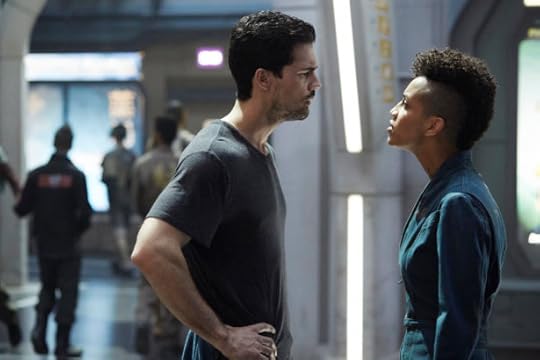
Meanwhile, refugees from Ganymede landed at the OPA outpost along with the charismatic faction leader Anderson Dawes (Jared Harris). Welcome back! What followed was a litany of minor characters having major revelations. Amos (Wes Chatham) got into a shoving match with a 5-year-old boy and lost, sending him to speak with Cortazar (Carlos Gonzalez-Vio) about the process that permanently removed his empathy. Cortazar, fully engaged in his Minority Report mode (a.k.a. the only mode he has) described the alteration’s effect as being “like a terrible storm had lifted,” so when Amos claims not to be interested, it’s the most obvious lie of the episode. The child protecting his mother reminded Amos of himself, of losing all the people who looked after him—and now he wants to lose himself.
Racial tension also burbled as the Belt-born and their Earthling allies clashed over life experiences and emotions neither could ever fully appreciate. That extended to Holden (Steven Strait) and Naomi (Dominique Tipper) just as Anderson snaked his way through the station to suss out secrets.
That speech Dawes gave about what to do with the nukes and what the Belter position needed to be in regards to Earth/Mars peace earned at least five fire emojis. It was a fantastic dramatic moment that Harris grabbed with both fists. A thrilling exchange, an amazing back-and-forth between ideologies in which Dawes surprised everyone by seeing the firm logic of returning the missiles to Earth as an act of good faith (and to earn a seat at the peace talk table). Imagine having that many nukes and choosing to give them back. It was a stroke of tactical genius, and even the bellicose Dawes was clever enough to understand that the most powerful weapons in the universe were useless.
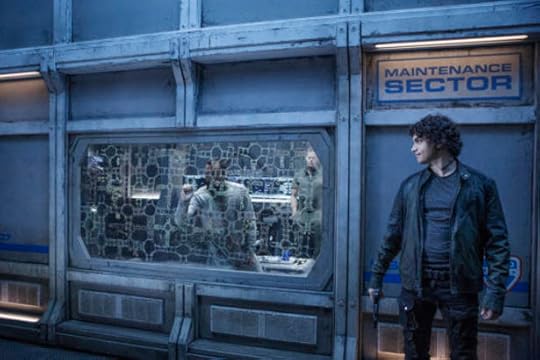
Sloshing his Bane-like vocal affect around the entire station, Dawes approached Naomi and Holden to try to learn the part of Johnson’s (Chad L. Coleman) strategy, unconvinced that they didn’t find anything that could help the Belt during all their journeys, questioning what card Johnson has left to play. Then he turned to Drummer (Cara Lee) with promises of booze and nostalgia, and then Diogo (Andrew Rotilio), with a musing on the alienating construct of time based on someone else’s planet’s rotation.
This was a master, sowing seeds of trust and watching some come to immediate fruition. Diogo, hypnotized by Dawes’ speech on creating meaning and birthing legends, gives up the ghost on Cortazar, who’s also just conveniently revealed he’s getting new data from more Protomolecule out there somewhere (wherever Naomi has it hidden…and maybe somewhere else, too?). Voila! The ace up Johnson’s sleeve.
Dawes and Diogo kidnapped Cortazar from the OPA HQ, and the Rocinante gave chase with Alex (Cas Anvar) shooting their thrusters to make them a floating barge. Bad news, though. Diogo was the only one aboard. Dawes and the freaky-minded doc were already gone, leaving all the cards up in the air before a meeting that could determine the fate of billions.
SOME STRAY THOUGHTS:
Seems shortsighted to keep most of your vegetable farming in one area, and, oh wait, that’s what we do on Earth, isn’t it?
Kudos to the show for showing PTSD not as some savage lashing out, but as a profound, internal struggle triggered by memories.
No one, except for Avasarala, seems smart enough to avoid war. So why do I get the sinking feeling something bad will happen to her soon?
Images: NBC/SyFy
Chris Hardwick's Blog
- Chris Hardwick's profile
- 132 followers



